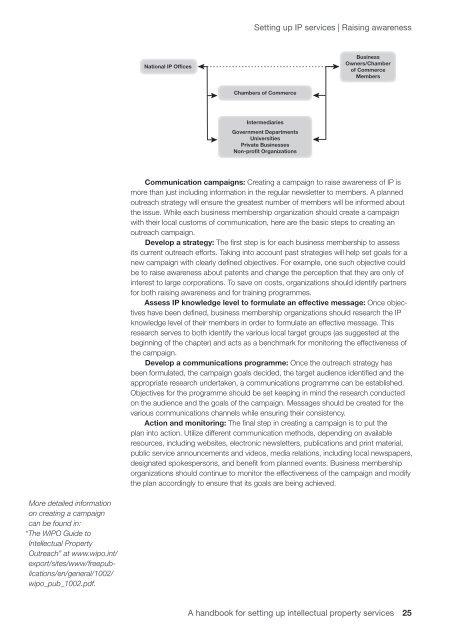Making intellectual property work for business - World Intellectual ...
Making intellectual property work for business - World Intellectual ...
Making intellectual property work for business - World Intellectual ...
Create successful ePaper yourself
Turn your PDF publications into a flip-book with our unique Google optimized e-Paper software.
More detailed in<strong>for</strong>mation<br />
on creating a campaign<br />
can be found in:<br />
“The WIPO Guide to<br />
<strong>Intellectual</strong> Property<br />
Outreach” at www.wipo.int/<br />
export/sites/www/freepublications/en/general/1002/<br />
wipo_pub_1002.pdf.<br />
National IP Offices<br />
Setting up IP services | Raising awareness<br />
Chambers of Commerce<br />
Intermediaries<br />
Government Departments<br />
Universities<br />
Private Businesses<br />
Non-profit Organizations<br />
Business<br />
Owners/Chamber<br />
of Commerce<br />
Members<br />
Communication campaigns: Creating a campaign to raise awareness of IP is<br />
more than just including in<strong>for</strong>mation in the regular newsletter to members. A planned<br />
outreach strategy will ensure the greatest number of members will be in<strong>for</strong>med about<br />
the issue. While each <strong>business</strong> membership organization should create a campaign<br />
with their local customs of communication, here are the basic steps to creating an<br />
outreach campaign.<br />
Develop a strategy: The first step is <strong>for</strong> each <strong>business</strong> membership to assess<br />
its current outreach ef<strong>for</strong>ts. Taking into account past strategies will help set goals <strong>for</strong> a<br />
new campaign with clearly defined objectives. For example, one such objective could<br />
be to raise awareness about patents and change the perception that they are only of<br />
interest to large corporations. To save on costs, organizations should identify partners<br />
<strong>for</strong> both raising awareness and <strong>for</strong> training programmes.<br />
Assess IP knowledge level to <strong>for</strong>mulate an effective message: Once objectives<br />
have been defined, <strong>business</strong> membership organizations should research the IP<br />
knowledge level of their members in order to <strong>for</strong>mulate an effective message. This<br />
research serves to both identify the various local target groups (as suggested at the<br />
beginning of the chapter) and acts as a benchmark <strong>for</strong> monitoring the effectiveness of<br />
the campaign.<br />
Develop a communications programme: Once the outreach strategy has<br />
been <strong>for</strong>mulated, the campaign goals decided, the target audience identified and the<br />
appropriate research undertaken, a communications programme can be established.<br />
Objectives <strong>for</strong> the programme should be set keeping in mind the research conducted<br />
on the audience and the goals of the campaign. Messages should be created <strong>for</strong> the<br />
various communications channels while ensuring their consistency.<br />
Action and monitoring: The final step in creating a campaign is to put the<br />
plan into action. Utilize different communication methods, depending on available<br />
resources, including websites, electronic newsletters, publications and print material,<br />
public service announcements and videos, media relations, including local newspapers,<br />
designated spokespersons, and benefit from planned events. Business membership<br />
organizations should continue to monitor the effectiveness of the campaign and modify<br />
the plan accordingly to ensure that its goals are being achieved.<br />
A handbook <strong>for</strong> setting up <strong>intellectual</strong> <strong>property</strong> services 25

















